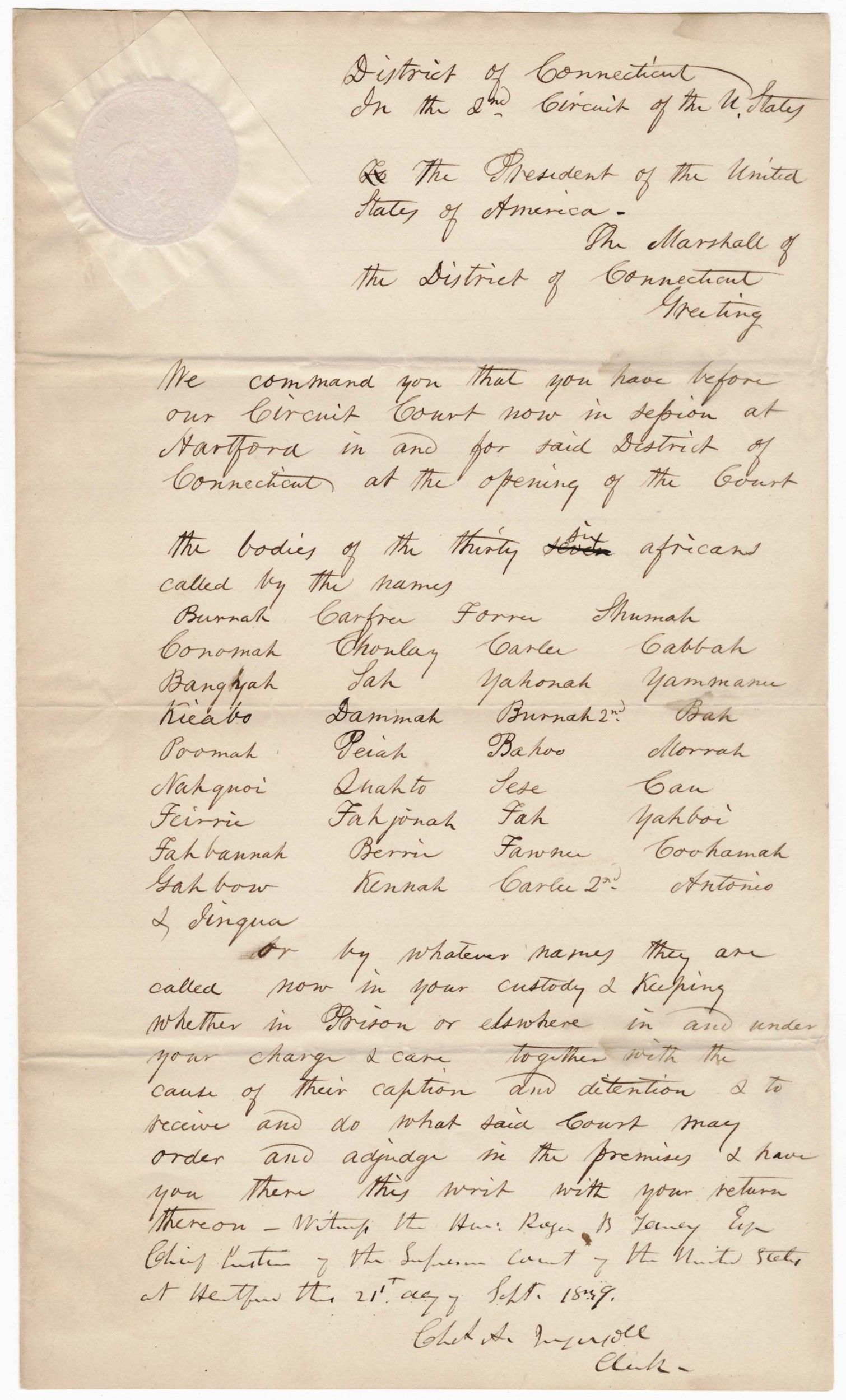Warrant for Habeas Corpus
9/21/1839
Add to Favorites:
Add all page(s) of this document to activity:

In February 1839, Portuguese slave hunters abducted a large group of Africans from Sierra Leone and shipped them to Havana, Cuba, a center for the slave trade. This abduction violated all of the treaties then in existence. Two Spanish plantation owners, Pedro Montes and Jose Ruiz, purchased 53 Africans and put them aboard the Cuban schooner Amistad to ship them to a Caribbean plantation. On July 1, 1839, the Africans seized the ship, killed the captain and the cook, and ordered Montes and Ruiz to sail to Africa.
Instead, they sailed north; and on August 24, 1839, the Amistad was seized off Long Island, NY, by the U.S. brig Washington. The schooner, its cargo, and all on board were taken to New London, CT. The plantation owners were freed and the Africans were imprisoned on charges of murder.
This document ordered Sengbe Pieh (also known as Joseph Cinque, and written as Jinqua on this document), the leader of the mutiny, and the other Africans who were aboard the Amistad to appear in court.
The murder charges were dismissed, but the Africans continued to be held in confinement and the case went to trial in the Federal District Court in Connecticut. The plantation owners, Spanish government, and captain of the Washington each claimed rights to the Africans or compensation. The court ruled that the case fell within Federal jurisdiction and that the claims to the Africans as property were not legitimate because they were illegally held as slaves. The U.S. District Attorney filed an appeal to the Supreme Court.
In January 1841, former President John Quincy Adams argued the defendants' case in the Supreme Court. He defended the right of the accused to fight to regain their freedom. The Supreme Court decided in favor of the Africans, stating that the Africans had never been enslaved but were free individuals, kidnapped and transported illegally. Thirty-five of them were returned to their homeland; the others died at sea or in prison while awaiting trial.
Instead, they sailed north; and on August 24, 1839, the Amistad was seized off Long Island, NY, by the U.S. brig Washington. The schooner, its cargo, and all on board were taken to New London, CT. The plantation owners were freed and the Africans were imprisoned on charges of murder.
This document ordered Sengbe Pieh (also known as Joseph Cinque, and written as Jinqua on this document), the leader of the mutiny, and the other Africans who were aboard the Amistad to appear in court.
The murder charges were dismissed, but the Africans continued to be held in confinement and the case went to trial in the Federal District Court in Connecticut. The plantation owners, Spanish government, and captain of the Washington each claimed rights to the Africans or compensation. The court ruled that the case fell within Federal jurisdiction and that the claims to the Africans as property were not legitimate because they were illegally held as slaves. The U.S. District Attorney filed an appeal to the Supreme Court.
In January 1841, former President John Quincy Adams argued the defendants' case in the Supreme Court. He defended the right of the accused to fight to regain their freedom. The Supreme Court decided in favor of the Africans, stating that the Africans had never been enslaved but were free individuals, kidnapped and transported illegally. Thirty-five of them were returned to their homeland; the others died at sea or in prison while awaiting trial.
Transcript
[Note: Question marks represent illegible text.]District of Connecticut
In the 2nd Circuit of the U. States
To The President of the United States of America –
The Marshall of the District of Connecticut
Greeting
We command you that you have before our Circuit Court now in session at Hartford in and for said District of Connecticut at the opening of the Court the bodies of the thirty seven six Africans called by the names
[names in table]
Burnah, Coromah, Bargyah, Kieabo, Poomah, Nahquoi, Feirrie, Fahbannah, Gahbow, & Jinqua [Cinque], Carfree, Chorlay[?], Lah, Dammah, Peiah, Shahto, Fahjonah, Berrie, Kennah, Forru, Carlee, Yahonah, Burnah 2nd, Bahoo, Lese, Fah, Fawnee, Carlee 2nd, Shumah, Cabbah, Yammanu, Bah, Morrah, Cau, Yahboi, Coohamah, Antonio
or by whatever names they are called now in your custody & keeping whether in Prison or elsewhere in and under your charge & care together with the cause of their captior [sic] and detention & to receive and do what said Court may order and adjudge in the premises & have you there this writ with your return thereon—writing the Hon Roger B Taney Esq. Chief Justice of the Supreme Court of the United States at Hartford this 21st day of Sept 1839
Ches. A. Ingersoll
Clerk
This primary source comes from the Records of District Courts of the United States.
National Archives Identifier: 2641484
Full Citation: Warrant for Habeas Corpus; 9/21/1839; United States v. Cinque and the Africans; Case Files, 1790 - 1911; Records of District Courts of the United States, Record Group 21; National Archives at Boston, Waltham, MA. [Online Version, https://docsteach.org/documents/document/warrant-for-habeas-corpus, May 14, 2024]Rights: Public Domain, Free of Known Copyright Restrictions. Learn more on our privacy and legal page.
